It was seven years ago when I first interviewed John Ross who last weekend celebrated his hundredth birthday with a family gathering at Curran’s Restaurant in Chapeltown.
He was 93 years old then and was as bright and cheerful as ever. I’ve decided to re-run these two articles I wrote for the Down Democrat to show how interesting and challenging a life John had.
At his celebration party he he spoke with his guests and family and the many friends still surviving who came along to wish him well. Although John’s hearing is now worse for wear, his is still very alert and very independent, and even cooks the odd meal for himself. He received a telegram from Her Majesty the Queen and also received one from the government of Ireland acknowledging his achievement in reaching 100 years.
So, please find below the two articles on John Ross which span the 20th century and beyond printed in the Down Democrat in October and November 2008.
Happy birthday John!
***
[caption id="attachment_57508" align="aligncenter" width="540"]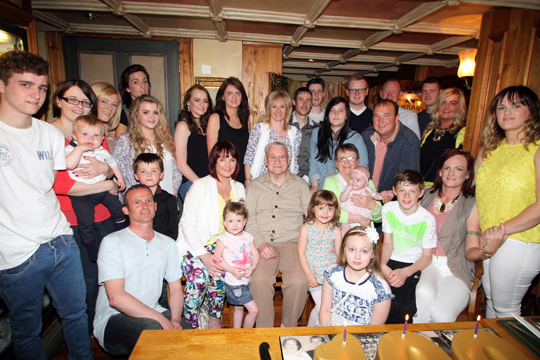 The younger members of John Ross’ family wish him a happy 100th birthday[/caption]
The younger members of John Ross’ family wish him a happy 100th birthday[/caption]
***
The Life and Times of John Ross – Part One
Last week [October 2008] I chatted to John Ross who lives in Meadowcourt in Ardglass.
He was born in 1915, and was a pupil of St Joseph’s School in Killough. Musing over his early years John said: ” I remember my teachers well… Ms Meehan, Ms McCLuskey, Mrs Denvir and Mr Buckley.
“None of them were interested in sport at all. We played a rough game of football in the very small playground with a tennis ball and sometimes the game even broke out into fights.
“My family built a wooden bungalow still in the Killough parish at Crewe corner in 1920 and we had stables to house four horses plus another out-houses.
“The 1920’s were great years in Ardglass for the herring trade and I remember our family getting a contract from Dunbar’s, the top herring curer’s from Scotland.
[caption id="attachment_57509" align="alignleft" width="270"]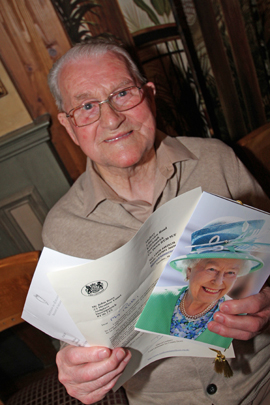 A spritely John Ross, 100 years old, celebrates his achievement with is family at Curran’s Chapeltown.[/caption]
A spritely John Ross, 100 years old, celebrates his achievement with is family at Curran’s Chapeltown.[/caption]
“Dunbar’s cured at the back of the old railway building where the gutter girls from Scotland and Donegal would work.
“The Crown Brand man would test the herrings by asking a cooper to turn up a barrel and remove the bottom. The inspector would bite the back of a herring tasting it, and if the different batches were up to standard, the Crown brand was stamped on them.
“A Russian ship used to arrive in Ardglass with barrels of salt and this gave work to the carters who loaded the barrels over to the quay.
“One day a couple of Hindus who worked abroad the Russian boat bought a goat from Willie Rea who lived in Crewe Hill.
“They took the goat down to the harbour where myself and my friends watched them kill it. Their main diet was sheep and goats apparently.”
And in 1932, John recalled the shark invasion around Ardglass.
“A large number of sun basking sharks appeared and one got caught in the net of a boat which was towed 30 miles out to sea before the crew managed to get the shark under control.” The shark died and they had to cut its tail off to free the drift net.
“Its body was dumped at sea and washed up at St John’s Point where it rotted away.
“But these sharks caused problems to the fishermen who did not take kindly to them especially when the sharks swam around the harbour.
[caption id="attachment_57512" align="alignright" width="390"]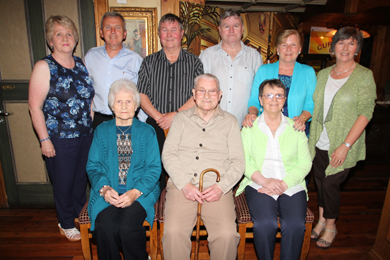 John Ross from Ardglass, 100 years old with his family members, pictured at a celebration party in Curran’s Chapeltown.[/caption]
John Ross from Ardglass, 100 years old with his family members, pictured at a celebration party in Curran’s Chapeltown.[/caption]
Sergeant Cook and others actually fired shots at them to scare them off, and depth charges were dropped into the harbour for many days before they eventually moved away.”
And John remembered too the outbreak of foot and mouth disease in the 1920’s which caused havoc to local farmers.
“At the farm at the back of the golf course there was an outbreak and all the cattle were slaughtered.
“Large pits were dug by hand and the carcases were laid in them and covered in quick lime then filled again.
“Farms at Ballee and Saul were also affected.”
When John left school in 1929, he started a job at Gilchrist’s farm at Coney island. In 1932, John delivered the first bottled milk in Ardglass for the Gilchrist’s working seven days a week from 6.30am to 6pm.
“Once I was kicked on the head by a young horse called Lucky. Thankfully it had no shoes on its back hooves, but I was badly concussed. And once I had another very near escape when riding a horse and cart. Driving down the Green Road the horse suddenly bolted.
“In front of me I saw Ms O’Hare in her Baby Austin and also Mrs Molloy pushing a pram accompanied by four children. So to stop the horse getting round the corner I pulled very hard on my right side rein and the horse pulled into the ditch and the cart crashed over with the empty grass seed bags scattering over the road. Fortunately the cart had a hay rack on it and it prevented it from turning right over.
“Both shafts of the cart had snapped off.”
After five years delivering milk in the days when there were no fridges, John was restless and wanted to move on.
He found a job with Starkey’s at Quarter Hill near Ardglass where he worked only five and a half days a week.
In 1935, John had the call for further adventure and along with a few others from around Ardglass joined the army, serving in the Royal Berkshires, an infantry division.
John said: “Of the 25 recruits in the Reading depot, 22 were Irish from the North and South.
“After basic training for five months, we were posted to Shornecliff camp near Folkesone for a month and were marched off to the Salisbury Plains for Grand Army manoeuvres as the Italians had invaded Ethiopia. Britain had a treaty with Egypt at that time to protect them in case of invasion.
“The world was a dangerous and changing place back then.”
Next week read in about John’s further exploits in part two of his trip down memory lane.
***
A life of hard work and much fun for John Ross – Part Two
Last week I covered the early life of John Ross who now lives in Meadowcourt in Ardglass.
His life has been long and colourful, and when he joined the Royal Berkshire Regiment in 1933, it led to an interesting time of travel and adventure across the Middle East.
“One day,” John said, “80 of us were given 48 hours leave. Along with similar groups from other regiments we were then off to Egypt on rusty old troop ships, and at Alexandria, the Italians had made an attempt to scuttle a boat at the mouth of the Suez Canal. But the British ships managed to pull it clear before it hit the bottom.
[caption id="attachment_57510" align="alignright" width="390"]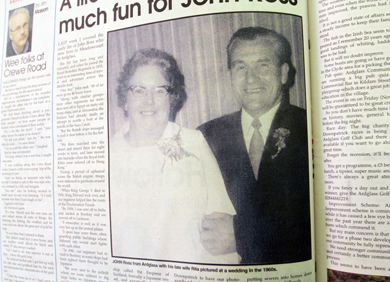 John Ross pictured with his late wife Rita back in the Sixties.[/caption]
John Ross pictured with his late wife Rita back in the Sixties.[/caption]
“We then marched into the desert and stayed there for eight weeks in tents, and later moved into barracks when the Royal Irish Rifles were ordered off to Hong Kong.”
During a period of upheaval across the British Empire, troops were stationed in garrisons around the world.
“When King George V died in 1936, King Edward took over, and our regiment helped line the route of the Proclamation Parade.
“By 1938, I was sent off to India and landed in Bombay and we moved off to Lucknow.
“I remember it well as it was very hot up in the central plains. I spent four years there, often guarding public buildings where different cats would start fights with each other.
“In 1941, our regiment had to rush to Bombay as some ships had been sighted there thought to be Japanese.
“We were sent to the airfield where we were ordered to dig large holes so Japanese aircraft could not land.
“But afterwards we found out it was a false alert as it was a British fleet that had been spotted.
“By then I had been promoted to corporal and had done medical training.
[caption id="attachment_57516" align="alignleft" width="390"]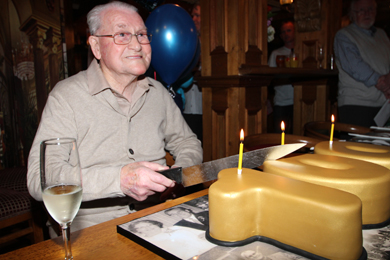 John Ross gets set to cut his cake celebrating his 100th birthday.[/caption]
John Ross gets set to cut his cake celebrating his 100th birthday.[/caption]
“After an altercation with a senior officer I was given a serious reprimand and I decided to revert to my old rank.
“At that point I applied for a transfer to the Royal Army Medical Corps and was accepted.
“During my eight years in the infantry I had enjoyed boxing, rugby, football and cricket, and was in a tug-of-war team which won the All-India Shield.
“I left India when I boarded a ship called the Empress of Scotland, formally a Japenese vessel, and eventually landing in Liverpool.
“The ship zig-zagged to avoid German submarines all the way to Cape Town with 1500 army personnel returning to England. She was a very fast vessel.
“My late wife Rita and I had eight children, with 24 grandchildren and 28 great grandchildren. Sadly Rita passed away in October 2002. It had been more than 58 years since I met her on the Loopline near Downpatrick in 1944 as I waited on the Ardglass train.
“We had met 10 years before so we exchanged addresses and wrote to each other and got engaged in 11 months.
“The wedding was in Dunsford chapel, and we went to Downpatrick to have our photographs taken by John Doris.
“Then we went on to Malachy Smith’s pub in Ballykinlar with Hooker kelly and his accordion for a knees up.”
But D-day was not far away and John was called up again into the RAMC. reverting back to corporal. On leaving the army at the end o the war, John worked in the Killough brickworks, and got a house in Killough, but eventually moved into the original home the Ross family had in the village. But it had been divided uo and the Carrol family used part of it as a holiday home.
Only after seven months with the brickworks, the business closed down and John got a job with William Teggart the builders.
“I remember it well. We were putting sewers into homes down the Quay Lane in Killough.
“But eventually I left and ended up with a job at RAF Bishopscourt – I worked for Limmer and Trinidad, operating a mixer making asphalt for the runways.
“After I was transferred in another big mixer making asphalt for roofing, and after that I helped make the concrete warming up bays for jets with Farvians and also the radar station at Killard with McCready’s.
“I had worked at Bishopscourt for 25 years when I retired in 1979. My family moved into a house in Meadowcourt where I now still live.”
As John look through his family album with me, I could see he has had an interesting, happy and fruitful life and continues to joy his big family.
]]>

























